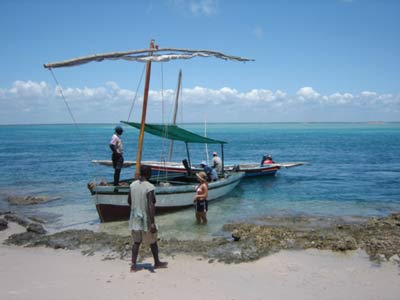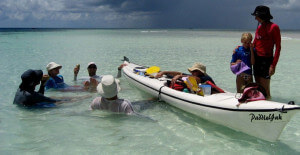|
|
|
|
|
WELCOME TO MOZAMBIQUE
- THE LAND OF SMILES
Once a Portuguese colony, Mozambique achieved independence
in 1975.
Area: 308,642 sq. miles;
slightly less than twice the size of California
Major cities: Capital - Maputo
(pop.1,6 million, 2011 est.) Beira, Matola,
Nampula, Quelimane, tete, Nacala,
Pemba.
Climate: Tropical to subtropical
Population (2011) 22.9 million
Ethnic groups: african 99,7% (Makhuwa,
Tsonga, Makonde, Lomwe, Shangaan, Shona, Sena, Ndau,
Europeans, Euro-Africans and South asians.
Religions Christian 56%, Muslim
18%, indigenous African and other beliefs
26%
Languages: Portuguese (official)
various indigenous languages
TOURISM
Mozambique is on the Indian Ocean coast of Southern Africa,
bordered by South Africa to the south, Tanzania to the north
and has inland borders with Malawi, Zambia, Zimbabwe and
Swaziland. Mozambique possesses a very long eastern
coastline along the Indian Ocean, a fantastic drawcard for
scuba divers, fishermen, sailors and beach lovers.

Maputo is the capital city of
Mozambique. It is the largest city of Mozambique also with
the country’s most important harbour. It is situated at the
mouth of the Santo River in the extreme south 90 km from the
border to South Africa.
Compared to some other sub-Saharan African cities the urban
area feels small and concentrated with wide avenues and old
trees. People are generally out and about in the streets,
walking driving and getting on with life. The vibe is
healthy and active, with little begging and lots of street
vendors and markets. There is no heavy presence of police
during the day, and no feeling that it is needed.
- The Railway Station on Praca dos Trabalhadores
was designed by Gustave Eiffel (after his fall from grace in
the Panama canal scandal), and bears the mark of his genius.
- The National Art Museum has a small but good
collection of Mozambican art, including several large
canvases by the world-renowned Malangatana.
- The Jardim Tunduru is a very pretty (albeit
small) botanical garden.
- The Museum of the Revolution chronicles
Mozambique’s fight for indepedence from Portuguese
colonialism.
- The Mercado Central in the Baixa district has
fresh fish, crabs, calamari, fruits and vegetables, and many
household staples. Safe, lively and recommended, especially
if cooking for yourself.
- Walk up Avenida Julius Nyerere. Start from the
Hotel Cardoso or Natural History Museum along R Mutemba to
Nyerere then left (north) to the Polana Hotel. Boutiques,
restaurants, curio vendors, video stores, etc. to be seen in
the relatively upscale Polana neighborhood.
- Visit some beautiful beaches, such as Catembe and Ponta
d’Ouro. Ponta d’Ouro is a popular destination for
South African divers and surfers. There is a small village,
but it is mostly overshadowed by the tourist camps. It is
very jovial in these atmospheres and it is not dangerous in
the least bit.
Inhambane is a sleepy historic town some
485 km north of Maputo. It has some great colonial
architecture (in a low-key sort of a way) and is considered
by many to be one of the prettiest towns in Mozambique. It
is situated on a peninsula overlooking a bay, and also
serves as a springboard to the coastal resorts around Tofo
beach (some 30 km due east, along a reasonably good
road). Tofo Beach has been described as “the next Goa”, and
while this may be pushing it a bit, Tofo has definitely
become a traveller’s mecca on the Eastern coast of Africa.
The reasons are not hard to discern: beautiful stretches of
beach, a friendly laid-back vibe, a small but pumping
nightlife, great diving and snorkeling and a few good
restaurants too.
Tofo and surrounds have some truly excellent diving, with
nice reefs and excellent large marine life. Whale sharks and
Humpback whales in season, reef sharks and much more. Don’t
miss Manta Reef, home of three cleaning stations where the
critters really throng. Most of the better dive sites are at
around 25-30 meters, requiring deep-dive certification
(which you can get through one of the dive shops if you
don’t have already).
Snorkeling is a MUST… swimming with whalesharks, the largest
fish in the world is incredibly special. Although their
mouths are over a meter wide and their bodies 8m long they
are harmless. if you’re lucky you may also get to swim with
wild dolphins, manta rays. Swimming with whales is
prohibited, although you’ll be happy to see them from the
boat. Inquire with the dive shops about trips. Surfing is
also a nice possibility in the warm Indian Ocean and boards
can be hired from the little cafe next to Diversity Scuba.
Vilanculos is a popular beach town and the
gateway to theBazaruto Archipelago, a group
of five idylic islands off the coast of Mozambique the
largest of which is Bazaruto Island. Others are Inhaca and
Paridise Island. The Archipelago is truly one of the most
beautiful destinations on the African continent. The area is
now protected as a conservation area and national park. The
park is one of the largest in the Indian Ocean and a crucial
achievement in global marine conservation.
Sand dunes are found throughout the Archipelago and tidal
flats and inland saline lakes support a wide variety of
seabird species. Coral reefs are also home to thousands of
fish and coral species and marine mammal species. The
largest dugong population along the eastern African coast
can also be found here.
Mile after mile of deserted sandy beaches also grace the
island. The leeward side of the island chain is surrounded
by calm turquoise waters while the windward side offers an
even more isolated and untamed seashore with waves
constantly pounding the coastline.
While offering an exquisite paradise, travelers may find
accommodations on the islands prohibitively expensive
particularly with the closure of the one of the last
reasonably priced accommodation Gabrielleť to make way for
yet another luxury lodge. Fortunately, Vilanculos offers a
plethora of affordable places to sleep. Daytrips by dhows
can easily be arranged from the mainland.
A untouched paradise on earth, the archipelago has earned
its reputation as the ‘Pearl of the Indian Ocean’.
Ilha de Mozambique is a city in Nampula
Province with a historical heritage that’s unmatched in the
rest of Mozambique, and indeed the rest of Africa. It was
the capital of Mozambique for nearly four centuries before
the move to Lourenco Marques (now Maputo), and had been used
as a major base for the arab traders long before the arrival
of the portuguese.
Everywhere. Ilha’s a magical mix of old portuguese and old
muslim architecture. It basically divides into two halves -
the old stone town in the north and the “reed town” in the
south. However the reed town here is set down from the main
streets. The museum is in the old Palacio Govierno, a big
red building up in stone town. In the same building is a
tourist information office that sells really good street
maps and has all sorts of other information about the
various restaurants and pensaos on the island. It’s well
worth heading here as soon as you arrive. Also well worth a
visit is the fort at the northern tip of the island, which
contains the Church of Nossa Senhora Baluarte, almost
certainly the oldest surviving European building in the
southern hemisphere, dating back to 1522.
There’s a dive centre at the northern end of the island just
down from the fort. You can take boat trips, visit the
museums, or just laze on the beach. If you’re feeling
adventurous take a dhow over to the mainland at Chaga or
Mossuril and explore along the coast there.
Nampula is the capital of Nampula Province in
northern Mozambique, surrounded by plains and rocky
outcrops. The city is connected by plane (LAM) to Maputo; it
hosts the regional market and is well supplied with shops,
banks, hotels and restaurants.Nampula is the staging post
for journeys further north (towards the Tanzania border) or
west (towards Malawi). The only passenger railway service in
the Country connects the town with Cuamba near the Malawi
border.Attractions
in Nampula include the large, domed cathedral and the
ethnology museum.
Pemba is
a port town in Mozambique located on the south side of the
world’s third largest natural bay. It is the most important
centre in northern Mozambique, and therefore has banks,
patisseries, supermarkets and restaurants, although the town
is very run down with paved streets having massive potholes
and other storm water damage. The town was built over
rolling hills, and most people live in wooden huts set
amongst many thick baobab trees.
The town is renowned for its Portuguese colonial
architecture. It was renamed Pemba at the end of Portuguese
rule, in 1975.
Pemba is also renowned as being a prime destination for
water sport and diving enthusiasts as a coral reef lies
close to the shore. Pemba has increasingly become a tourist
destination, particularly for upper-middle class Mozambicans
and South Africans. There is now a weekly flight from
Johannesburg to Pemba, a five-star hotel, the Pemba Beach
Hotel, restaurants, and other forms of entertainment.
Tel: 011 431
4067

Ibo Island Lodge is the only Mozambique Island Resort to
offer fully supported dhow and sea kayak safaris in the
Quirimba’s Archipelago. There are 32 islands to explore –
fantastic diving and snorkelling in one of the last remote
parts of the African coastline. Our standard recommended
minimum itinerary includes 4 nights island hopping by dhow
or kayak and 3 nights at Ibo Island Lodge – but you are free
to tailor make your perfect adventure! Perfect for groups of
friends and family. So choose between a Tailor
Made Safari or join groups of like minded travellers on
a Scheduled
Departure.
Sail off on a unique Mozambique Holiday under the expert eye
of a professional guide and local crew. Snorkel off deserted
white sandbanks into clear blue seas then camp overnight on
secluded Quirimba’s island and beaches eating fresh seafood
on the fire.
Ibo Island Lodge knows the northern Mozambique region
intimately so come aboard and enjoy un-equalled natural and
cultural journeys of discovery. Create your own itinerary to
suit your specific needs. Many independent travellers use
one of our dhow safaris as part of a romantic Mozambique
honeymoon package.

Ibo Island Lodge also offers incredible Sea
Kayak Safaris throughout the Quirimbas
Archipelago. Combine sea kayaking with sailing
and island hopping aboard your support vessel – a
traditional dhow equipped to support the paddlers
and your group.
Depending on your level of fitness and
experience paddling distances can vary and time can
be spent paddling off the support vessel if weather
conditions require this. Longer expedition style
paddling trips are especially popular with groups
and can be arranged on request. We can cater for up
to 20 paddlers at one time. This is adventure travel
at its best!
|



